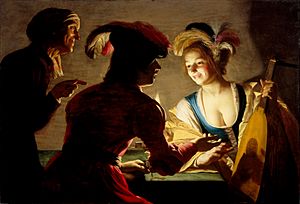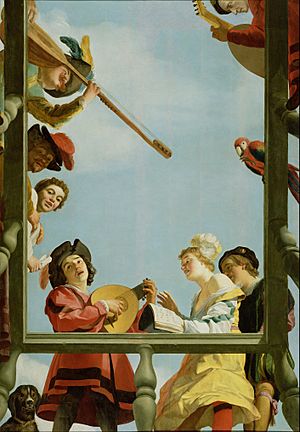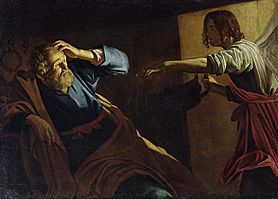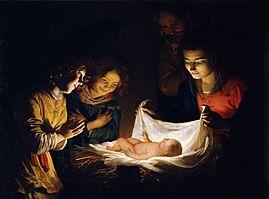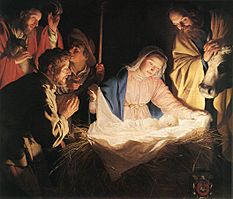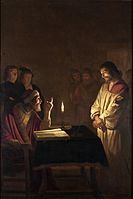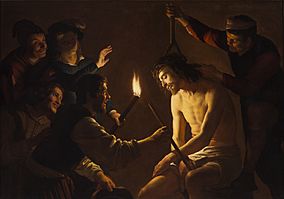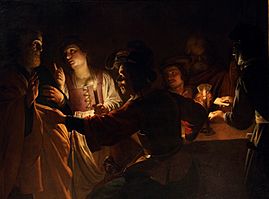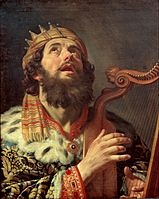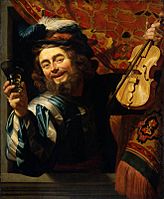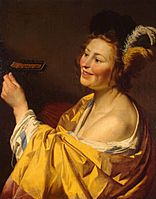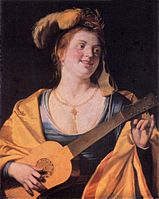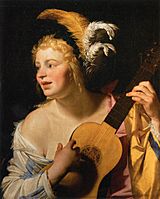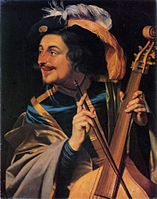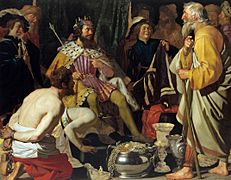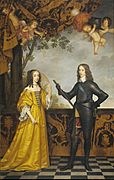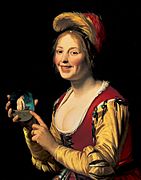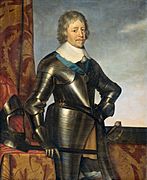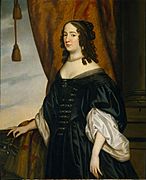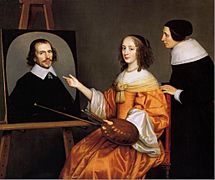Gerard van Honthorst facts for kids
Gerard van Honthorst (born November 4, 1592, died April 27, 1656) was a famous painter from the Netherlands during the Dutch Golden Age. He was known for his paintings that looked like they were lit by artificial light, like candles or lamps. Because of this, people sometimes called him Gherardo delle Notti, which means "Gerard of the nights." Early in his career, he traveled to Rome, Italy. There, he was very successful and his painting style was inspired by another famous artist named Caravaggio. When he came back to the Netherlands, he became a top painter of portraits.
Contents
Gerard van Honthorst's Early Life
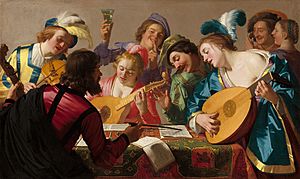
Gerard van Honthorst was born in Utrecht, a city in the Netherlands. His father was a painter who decorated buildings. Gerard learned to paint from his father first. After that, he continued his training with another artist named Abraham Bloemaert.
Time in Italy
After finishing his training, Honthorst went to Italy. Records show he was there by 1616. He was one of several artists from Utrecht who traveled to Rome around that time. These artists were greatly influenced by the new art styles they saw there. They became known as the Utrecht Caravaggisti. Other artists in this group included Dirk van Baburen, Hendrick ter Bruggen, and Jan van Bijlert.
In Rome, Honthorst stayed at the palace of Vincenzo Giustiniani. There, he painted a work called Christ Before the High Priest, which is now in London's National Gallery. Giustiniani had a large art collection. Honthorst was especially inspired by artists like Caravaggio, Bartolomeo Manfredi, and the Carracci family. Honthorst became famous for painting scenes that looked like they were lit by artificial light. Another important supporter was Cardinal Scipione Borghese. He gave Honthorst important jobs at churches in Rome and nearby towns. Honthorst also worked for Cosimo II de' Medici, Grand Duke of Tuscany, a powerful ruler.
Coming Back to Utrecht
Honthorst returned to Utrecht in 1620. He quickly became very well-known in the Dutch Republic and in other countries. In 1623, the same year he got married, he became the head of the Guild of St. Luke in Utrecht. This was a group for artists.
He became so popular that important people, like Sir Dudley Carleton, who was an English ambassador, suggested his paintings to other nobles. In 1626, Honthorst even hosted a dinner for the famous painter Rubens. He painted Rubens in a picture showing the ancient Greek philosopher Diogenes.
Painting for Royalty
Elizabeth of Bohemia, who was the sister of Charles I of England, lived in the Netherlands after being forced to leave her home country. She hired Honthorst as her painter. He also taught her children how to draw. Through her, Honthorst became known to King Charles I, who invited him to England in 1628.
In England, Honthorst painted several portraits. He also created a very large painting, now at Hampton Court. This painting showed King Charles and his queen as the gods Diana and Apollo. It also included the Duke of Buckingham as the god Mercury, protecting the King of Bohemia's children. Honthorst also painted a more personal group portrait of The Four Eldest Children of the King of Bohemia. In this painting, the two oldest children were shown as Diana and Apollo.
After returning to Utrecht, Honthorst continued to paint for the English king. In 1631, he painted a large picture of the King and Queen of Bohemia with all their children. Around the same time, he painted scenes from the ancient Greek story of the Odyssey for Lord Dorchester. He also painted historical scenes for Christian IV of Denmark. He even painted a portrait of the king's daughter, Countess Leonora, when she was in The Hague.
Honthorst was so popular in the Netherlands that he opened a second art studio in The Hague. There, he painted portraits of people from the royal court and taught drawing. These large studios had many students and assistants. One student, Joachim von Sandrart, said that Honthorst usually had about 24 students at a time. Each student paid a good amount of money each year for their lessons.
Honthorst's brother, Willem van Honthorst (1594–1666), was also a portrait painter. Many of Willem's paintings were once thought to be by Gerard because their signatures looked similar. Willem learned from Abraham Bloemaert and also from his older brother. In 1646, Willem went to Berlin. There, he became the court painter for Louise-Henriette, who was married to the elector Frederick II. Willem returned to Utrecht in 1664.
His Famous Nickname
Today, people in Italy often call Honthorst "Gherardo delle notti," which means "Gerrit of the Nights." However, this nickname was not used during his lifetime. Italian documents from before 1656 called him "Gherardo Fiammingo" ("Gerrit the Fleming") or "Gherardo Hollandese" ("Gerrit the Dutchman"). These names focused on him being from another country, not on his special skill with light. The nickname "Gherardo delle notti" only became widely used in the 1700s.
Honthorst's Legacy
Honthorst was a very busy artist who painted many works. His most interesting paintings are often those where he used Caravaggio's style. These often show scenes in taverns (old pubs) with musicians, people playing games, and people eating. He was very skilled at chiaroscuro, which means using strong contrasts between light and dark. He often painted scenes lit by just one candle.
Some of his famous works include portraits of the Duke of Buckingham and his family (at Hampton Court). He also painted the King and Queen of Bohemia (in Hanover and Combe Abbey). Other portraits include Marie de' Medici (in Amsterdam Stadthuis, 1628), and the Stadtholders and their Wives (in Amsterdam and The Hague). He also painted Charles I's nephews, Charles Louis and Rupert (at the Musée du Louvre, St Petersburg, Combe Abbey, and Willin). His early style can be seen in the Lute-player (1614) in the Louvre, the Martyrdom of St John in Santa Maria della Scala in Rome, or the Liberation of Peter in the Berlin Museum.
Sadly, his 1620 painting The Adoration of the Shepherds in the Uffizi gallery was destroyed in a bombing in 1993.
In November 2013, Honthorst's 1623 painting The Concert was bought by the National Gallery of Art in Washington, D.C.. It had not been seen by the public since 1795. This large painting, about 1.23 meters by 2.06 meters (4 feet by 6.7 feet), was shown for the first time in 218 years at the National Gallery of Art on November 23, 2013. It was on display for six months before becoming a permanent part of the museum's Dutch and Flemish art collection.
Gallery
- Gerard van Honthorst's religious paintings
-
Christ before the High Priest, around 1617, National Gallery, London
-
The Denial of Saint Peter, around 1620
- Gerard van Honthorst's paintings of musicians
-
The happy Fiddler, 1623, Rijksmuseum Amsterdam
-
Man with viola da gamba
- Other
-
Solon and Croesus
-
Margareta Maria de Roodere and Her Parents (around 1652), Centraal Museum, Utrecht
Images for kids
See also
 In Spanish: Gerard van Honthorst para niños
In Spanish: Gerard van Honthorst para niños



